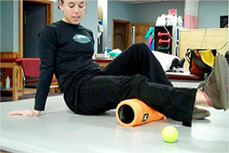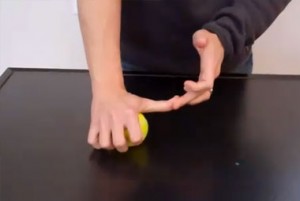In this level, you will find four types of workouts: 1) stretching, 2) self massage, 3) strengthening, and 4) kinesiology taping.
- Stretching: The goal here is simple. we want to build slack back into the leg chain as a whole, especially the calf. Since the anatomy crosses three joints, we will start by covering all three. As mobility improves and you progress through this course, we will be eliminating muscle groups and narrowing our focus.
- Self Massage: In level one, we will be using a foam roller/massage stick. Just like with the stretches, we will be working one joint above and below to make sure each of the layers of muscles in the calf is loosened up. The focus in this lesson will be learning how to flush out an area using the elongation technique.
- Strength: In level one, our strength work will be focused on restoring balance to the opposite end of the leg chain. Why? A strong core will be able to hold your pelvis regardless of what you’re legs are doing. That means full access to the larger hip muscles so that your poor calf can get some much needed help.
- Kinesiology Taping (optional): When things are sore and achy, taping is a great way to prolong the benefit of your mobility and strength work. This tape is not the rigid athletic tape you may be familiar with from team sports. This is elastic tape that pulls against itself to provide proprioceptive feedback. We’ll dive into this later in the lesson.
Here are the details:
| Stretching Routine | Roller/Stick Routine | Strength |
|
|
|
| 30 second hold for each | 1 minute per muscle group | 5 second hold, 10 reps of each. |
| Total time for workout = 4 min per leg | Total time for workout = 8 min per leg | Total time for workout = 9 minutes |
One or both legs for the stretches and self massage?
This is completely personal preference and based on how much time you have available to you that day. For me it’s simple? If I have the time, I do both. If I don’t, I focus on the leg where my symptoms are. At the very least, I recommend trying your “good” leg at least once. It may not be symptomatic at all but it may be just as tender or surprising as the one you are focusing on.
How often?
| Day One | Day Two | Day Three | |
| “Good” | stretch | self massage | strength |
| “Better” | self massage + stretch | stretch + strength | self massage + stretch |
| “Best” | stretch am + self massage/stretch pm | strength am + stretch pm | stretch am + self massage/stretch pm |
The key with any formal self massage or mobility work is that you want to be consistent and you want your sessions to be repeatable! Having a killer session that leaves you sore for three days will not speed up your recovery. In fact, it will probably make it worse. Here are some guidelines:
- Above you will see three options: good, better and best. These options are all based on the free time you have available.
- “Good” is the minimum. Pick one workout a day and make sure it gets done. If you find yourself having free time, make stretching the priority at this stage in the recovery.
- “Better” means finding those four minutes to stretch every day. The good news? Even with the extra work, you’re still looking at less than 15 minutes a day.
- “Best” means two a days. This set up isn’t forever. It’s just to get that initial mobility boost you need to see quick results.
Ground rules:
- Go easy the first time through! It is very possible to overdo this stuff and the “no pain, no gain” mentality will likely just slow down your recovery.
- If you do find yourself sore after the first session, follow with 10-15 minutes of ice and take the next day off from the massage/strength work. Gentle stretching is okay.
- When you are able to do these routines without soreness or difficulty, you can progress to level two.


